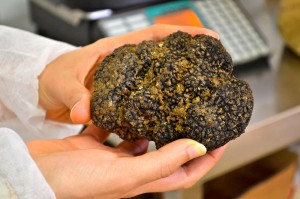Truffles are the heart of a multi-million dollars business employing thousands in the region.
ACQUALAGNA, Marche, Italy – While some families may bequeath future generations treasured photographs and furniture as heirlooms, the Bartolucci clan of this small town in central Italy passes down something larger: Truffle-rich mountains.
“These mountains are what the vineyards are to Tuscany,” said Emanuela Bartolucci, owner of Acqualagna Tartufi factory. “They are the most expensive mountains in the world.”
It may not be exaggeration. Italian white truffles are the most esteemed and valuable on the market. According to the National Restaurant Association, in December 2009 the Alba, Italy Tuber magnatum variety of truffles sold for roughly $710 per pound. And in 2007, a 3.3-pound truffle from Pisa sold for $330,000.

“The dirt acts as a protective covering,” said Bartolucci. “We do not wash it off until we are ready to ship the truffles.”
Truffles are a type of mushroom that grows underground . While there are hundreds of types of truffles, the species prized by gourmets primarily come from specific areas of Italy and France. Reliant on tree roots for nutrients, they are almost always found in heavily forested areas, most often those with plenty of oak trees.
This global delicacy is known for its pungent, but rich flavor. Different varieties of truffles used on cooking are produced at different times of the year in Italy. The white truffle is typically produced in the fall and the black truffle in the summer.
“The beauty of the truffles, according to me,” said Bartolucci, “is that it is an intelligent mushroom,” explaining that the truffle is aware of how it should react to weather conditions. “When the ground is too hard or too cold, the truffle protects itself and goes deeper into the earth,” he added
Acqualagna claims it is the capitol of the truffle industry because, according to Bartolucci, its surrounding mountains are the only place in the world where one can find all nine marketable varieties of truffles.
[pullquote]You can find truffles more or less all over the world, but the microclimate here makes it possible to have different varieties of truffles with specific properties that make it unique in Italy.[/pullquote]
“You can find truffles more or less all over the world,” said the native of nearby Apecchio. “But the microclimate here makes it possible to have different varieties of truffles with specific properties that make it unique in Italy.”
In this town of 4,000, truffles, or “tartufi” in Italian, are the center of life. The mountains that encase the community about three hours southeast of Florence are cloaked with truffle-producing forests. The quaint streets of the village are lined with enticing truffle restaurants, and the unforgettable scent of truffles fills a visitor’s nostrils as he steps off the bus. It is the type of town where friends chat at for at cafes and family dinners continue late into the night – dinners that often feature truffles.
Acqualagna boasts three truffle festivals each and the truffle industry has become a multimillion-dollar business in the town, with the largest company’s taking in about 35 million Euros annually, according to Bartolucci.
That economy helps employ a legion of workers who collect truffles – the truffle hunters who use dogs trained to detect the scent of the fungi as they walk through the forest. Because truffles bury themselves deep underground, they are not detectable by the human eye or the human nose and hunters rely on a dog’s keen sense of smell. Once the dog marks a truffle, the hunters carefully digs it up.
Many of Acqualagna’s truffle hunters have been in the business for generations working Bartolucci’s farm.
“In this province of Pesaro-Urbino there are 22,000 truffle hunters,” said the farmer. “In the entire valley there are 200,000. That’s a big number of truffle hunters.”
But there is also some science to the art of truffle hunting.
“There is a pattern that repeats itself every year,” said Bartolucci. “If you find a truffle that is big you can almost be certain that next year it will be the same size in the same location.”
Bartolucci’s factory produces roughly 880 pounds of truffles every day. Once delivered to the factory truffles are cleaned and either shipped to a client or made into one of the many Acqualagna Tartufi products, including truffle butter. oil and salsa.
The factory, about the size of a modest house, exports products to clients globally.
“I have clients all over the world,” said Bartolucci. “All over the world.”
Multimedia